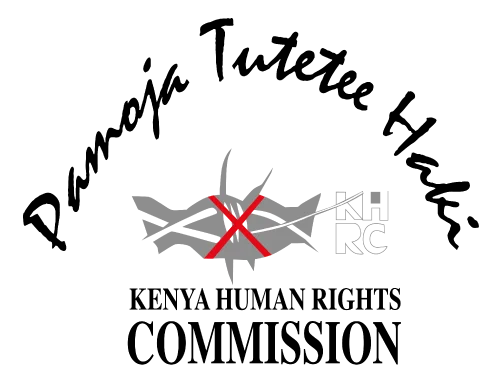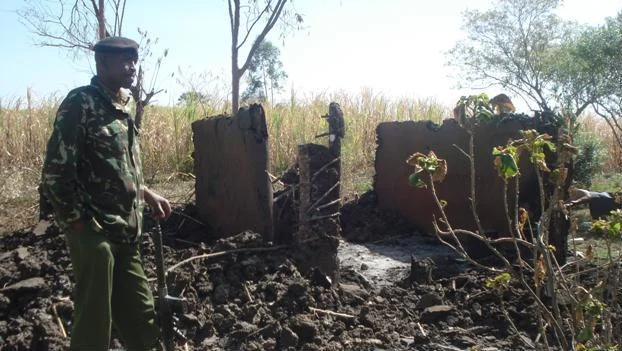In his report, Mr. Obura stated that the history of conflict in that region had largely been based on cattle rustling or livestock theft, unresolved land grievances and political issues. The areas affected by the current cycle of conflict were identified to be Tinderet, Muhoroni and Aldai districts. In his estimation, the overall results of the violence that began on the evening of February 25, 2012 were 10 fatalities, 22 persons injured, 1,576 Internally Displaced Persons (IDPs), 100 houses burnt down, 217 houses looted, over 222 acres of sugar cane burnt down and an unknown number of cattle stolen. It is on the basis of this report and media coverage on the same that the KHRC urgent action committee resolved to conduct a fact-finding mission in the region.
The Findings
The findings of the KHRC fact-finding mission are of great concern.
- While relative calm has been restored in the area following the deployment of General Service Unit (GSU) officers in the region, the victims however view such calming of tensions as temporary in the absence of a permanent presence of GSU officers in the area and additional police posts at the incident sites. Security concerns therefore remain a foremost issue.
- It was evident that the government through the then provincial administration had provided some measure of humanitarian assistance to the victims; however, there are substantial concerns that need to be addressed. For instance Owiro Primary School and the then Muhoroni District Commissioner’s office offered safe haven to victims fleeing the conflict but did not have a sufficient number of tents to house the families seeking refuge. The camps established reportedly received food rations which were deemed as insufficient by the displaced families.
- While some information is available through consultations between the victims and the offices of the then District Commissioner, there has been no concerted effort to conclusively and comprehensively document the true impact of the conflict in terms of injuries, the number of persons displaced, loss and damage to property. As a result there is no authoritative database of IDPs emanating from this conflict and this is bound to adversely affect the assistance and protection accorded to them.
- Further, there has been no indication or undertaking from government officials to assist the displaced persons reconstruct their burnt down houses or restore their livelihoods in light of their lost crops and livestock.
- What is worrying though is that there are inconclusive reports that attribute the current cycle of conflict to factors that go beyond the conventional wisdom of cattle rustling/ livestock theft. These include: tensions around land settlement schemes and in particular, the Kibigori plantation project; and political tensions currently exacerbated by the ongoing Kenyan cases before the International Criminal Court (ICC) and the ethnic ties of some of suspected perpetrators and some of the accused persons at the ICC. Some victims further accuse various local politicians and private citizens of supporting the violence by offering the perpetrators financial and other forms of material support.
- The victims of this conflict have suffered a similar fate of displacement in previous episodes of conflict and there is growing support for resettlement as the most viable durable solution.
- Commendable, though, is that there are ongoing attempts at reconciliation through dialogue forums between the Luo and Nandi as communities most affected by the conflict. Indeed, the National, Cohesion and Integration Commission (NCIC) during a baraza, encouraged the community members to continue the process of dialogue. The mission team however noted a dissenting opinion from some community members who felt the dialogue process was thus far superficial and did not address the true underlying causes of the conflict such as land.
Recommendations
In light of the aforementioned findings, the mission team makes the following recommendations:
- The government through the Ministry of State for Special Programmes (MoSSP) takes the lead in coordinating a comprehensive programme that will see both the immediate and long-term assistance needs of IDPs from this conflict addressed. In the short-term, the government should provide: sufficient food rations, tents for shelter, medical supplies and clean drinking water. In the long-term, the government should provide support in the reconstruction of burnt down shelters and support the resumption of livelihoods through the recovery of livestock and support in replenishing lost crops. The support of humanitarian agencies should also be sought in facilitating such assistance.
- The MoSSP should coordinate the documentation and profiling of IDPs from the conflict as a matter of urgency. The IDPs must however be consulted and be active participants if the profiling process is to be legitimate and valid.
- The government should consider lasting solutions to the security concerns in the area such as the establishment of permanent police posts in the areas that have consistently registered instances of livestock theft.
- The police in the course of its investigations should explore the validity of allegations that the conflict was orchestrated and supported by various politicians and private citizens and in the presence of conclusive evidence, arrest and prosecute such persons.
- The attempts at community dialogue must be maintained and encouraged with the support of the local administration, NCIC and relevant non-state actors.
- An analysis of the conflict trends and the underlying issues fueling the conflict must be undertaken. This will assist in identifying the true drivers of the conflict and isolate them for resolution.
Given the findings above, failure to adequately and conclusively address these issues, leaves communities sitting on a time bomb, vulnerable to clashes reminiscent of the 2008 PEV.
KHRC in conjunction with other relevant stakeholders continue to monitor the situation in this area with a view to assessing ongoing efforts of assistance and recommending the most viable durable solutions.
KHRC’s fact-finding mission was conducted by a three-member team namely George Morara, Andrew Songa and Eva Kaloki, all of the KHRC, accompanied by Mr. Obura. The mission, conducted over a period of two days from March 8-9, 2012, consisted of visits to sites of violence, interviews with the provincial administration and interviews with a cross-section of victims.
Due to time constraints, the mission team was only able to visit two epicenters of the conflict, namely: Nyangore sub-location in Muhoroni district and Owiro farm in Tinderet district. Some of those interviewed included: Mr. Washington Obura, IDP Network Coordinator for the Kisumu region; Helen Ongere HURINET Coordinator for Nyando region; the then District Commissioner for Muhoroni District, Mr. Ake Abwaku Solomon and a total of eight victims from Nyangore sub-location and Owiro farm.
Compiled by Andrew Songa and edited by Beryl Aidi


